.
On my balcony, what for a while had been a fat, round bud, suddenly exploded under spring’s pressures. A peony it is -methinks; I am a lover of flowers, not a botanist. Curiously enough, there are more vigorous stems sprouting from the pot’s soil, which has been refreshed weeks ago; yet, only one of them has produced this miracle. Could the peony be a thrifty creature?
It attracts bees. It has the size of a fried egg, as well as its appetizing colours. Then, when in the late afternoon I returned to the balcony to have my pleasure redoubled, the late sun already behind the house, to my surprise the flower had closed up, perhaps saving its honey and fragrances for the bees who plan their arrival tomorrow. Once again, an indication of frugality.
.
.
In a very roundabout way, it reminded me of a camping trip, made years and years ago. It was already mid-September, we were travelling rather mountainous parts of France, on the lookout for a place to put up our tent for the night. On the side of an open gate, a sign told us Camping Ouvert – home we were! Considering the fact that the ‘season’ had ended, we had already found quite a few campsites closed up for winter. Not this one – ouvert!
We had to descend a spiralling, car-narrow path, all over strewn with rocks. Down in the pit, around one last bend, we had to stop for a second gate, this time a closed one with a sign Camping Fermé… Stuck, in the middle of nowhere, more specifically down in nowhere. With the car’s nose down, there was no other way but backtracking in reverse, all the way up. Ever since that day, in our house – whenever someone puts you into a pragmatic paradox, which often happens in married life – it has become a hallowed expression: Ah, un Camping Ouvert-Fermé!
True to the French character, so well described by Molière in his l’Avare – the Miser – the owners of that campsite must have been as frugal as my peony, not willing to spend time on removing the sign at the top of the pit, and pay for another one to announce what had indeed been written on the sign down there in Hell. As the peony’s flower, the campsite behind the closed gate had looked like a little Paradise. Surely, a Dante experience.
.
Sierksma, Montmorillon 17.5/2024













